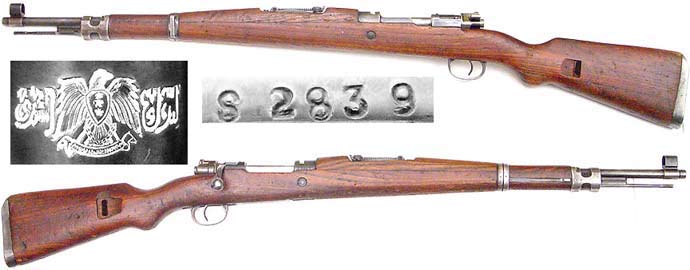
The next innovation was the Model 1893. This rifle is commonly referred to as the "Spanish Mauser", although the model was adopted by other countries in other calibers, most notably the Ottoman Empire (Turkey). The M93 introduced a short staggered-column box magazine as standard, holding five 7x57mm rounds flush with the bottom of the rifle, which could be quickly reloaded by pushing a strip of rounds down from the top of the open bolt. The new 7x57mm round became the standard round for the Spanish armed forces, as well as for the militaries of several Latin American nations, and is dubbed, in common usage, the "7mm Mauser".
A higher power version of this model in a Spanish cartridge was employed by the Spanish Regulars in Cuba. It gained a reputation for its use during the 1898 Battle of San Juan Hill in Cuba where 750 Spanish regulars significantly delayed the advance of 15,000 U.S. troops armed with a mix of .30-40 Krag-Jørgensen and some older Trap-Door Springfield rifles. There was little difference in performance between the Spanish M93 and the Krags at the ranges involved, but, compared to the Springfield, the use of smokeless powder gave a serious advantage to Spanish soldiers. In addition, The M93's stripper clip system allowed the Spanish soldiers to reload far more quickly than was possible with the Krag, the magazine of which had to be loaded one round at a time. All of this likely played a role in the U.S. in licensing the Mauser locking technology for the Krag's replacement, the M1903 Springfield rifle.
As soon as the Ottoman Army learned about the new Spanish Model of 1893, they placed an order for about 200,000 rifles in the same configuration. Their rifles were chambered for the 7.65x53mm Mauser cartridge, and were virtually identical to the Spanish model, except for the addition of a unique magazine cutoff which permitted the feeding of single cartridges, while keeping the magazine full.
The Spanish Mauser Model 1893 was adopted on December 7, 1893. Because of the technical advances and famed accuracy the Model 93 Mauser is one of the best known Mausers of all time. It was the first Mauser to introduce the staggered row, integral box magazine that is flush with the rifle's stock. The Model 93 gained fame facing U.S. troops in the Spanish-American war of 1898 and is attributed with lending to the decision to replace the U.S. 30-40 Krag with the U.S. Springfield 1903 as the U.S. Army's primary battle rifle. They were used right up until the 1950s.
Later developments
In 1943 Spain adopted the the Mauser 98 rifle as standard for its military. Designated the M43, this rifle was essentially the famous German K98k cham- bored for the 7.92x57mm (8mm Mauser) cartridge. These are also often referred to as Spanish Mausers.

M43 Spanish Mauser

FR8 (7.62mm)
This carbine was made from a Spanish M43 short rifle. Barrel and front sight are from a CETME and the rear sight was welded to the receiver. This carbine was made for training purposes and fires the power reduced .308 CETME cartridge. Length is 38.8 inches barrel is 18.5 inches and weight is 7.5 lbs. Its true designation is FR8 SP or Special Purpose Rifle.





